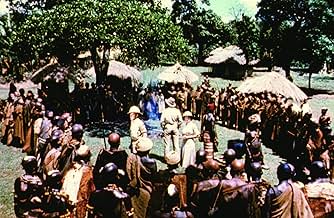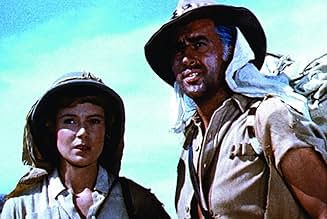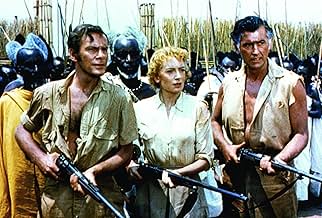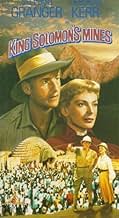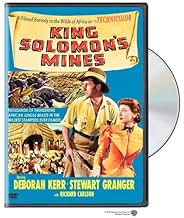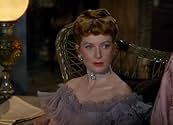Füge eine Handlung in deiner Sprache hinzuAdventurer Allan Quartermain leads an expedition into uncharted African territory in an attempt to locate an explorer who went missing during his search for the fabled diamond mines of King ... Alles lesenAdventurer Allan Quartermain leads an expedition into uncharted African territory in an attempt to locate an explorer who went missing during his search for the fabled diamond mines of King Solomon.Adventurer Allan Quartermain leads an expedition into uncharted African territory in an attempt to locate an explorer who went missing during his search for the fabled diamond mines of King Solomon.
- Regie
- Drehbuch
- Hauptbesetzung
- 2 Oscars gewonnen
- 4 Gewinne & 2 Nominierungen insgesamt
- Chief Gagool
- (as Sekaryongo of the Watussi Tribe)
- King Twala
- (as Baziga of the Watussi Tribe)
- Chief Bilu
- (Nicht genannt)
- Austin - Safari Client
- (Nicht genannt)
- Black Circle
- (Nicht genannt)
- Kafa - Umbopa's Old Uncle
- (Nicht genannt)
- Traum - Safari Client
- (Nicht genannt)
Empfohlene Bewertungen
The film is very exciting. And you feel for the characters when they come into contact with danger. I wish more action films could make you do that. The performances are the reason behind this. It's too bad that the actors and actresses in the film weren't nominated for Oscars. I doubt they deserved to win, but they deserved to be up.
The script is also very good. It strays away from the book just a little bit. But I have no problem with that because the film, by itself, is very good.
The cinematography and editing are flawless. And they rightly won Oscars. The film was also nominated for Best Picture. It's one of the better adventure films.
Secondly, the MGM crew of about 30 people and 7 cargo trucks spent months in 1949 filming this on the Dark Continent itself, at locations hundreds of miles from civilization in eastern Africa instead of the usual Hollywood lots. They enlisted the inhabitants of remote villages as actors, asked them to perform communal dances, and took many close-up shots of their faces, hair, headgear, jewelry and body paint. This amounts to some of the most magnificent - and rare - color and sound footage of "old" untouched African culture I've seen.
Not long after this, during the 1950's-1960's these villages gradually became part of the modern world, and by the 1980's, remote tribesmen were filmed as they hunted with spears - wearing "Michael Jackson" t- shirts.
The movie is generally pretty good, but the Africans steal the show.
Of course, that was before TV brought the world into living rooms everywhere. The movie may have lost that long ago novelty, but it's still a good story set in what was then colonial Africa, with a first-rate cast, including the exotic Umbopa, the prince in exile. Then there's that thundering stampede whose mighty numbers still impress.
Like many reviewers, I cringe now at the elephant kill. I'm sure I didn't at the time, but then this ecological type change reflects a newer awareness, and one I think for the better. Actually, Quartermain (Stewart) is also bothered by big game kills, one reason he's ready to give up his hunting safaris.
Happily, Stewart's persuasive as the experienced white man, while Kerr does nicely as the British gentlewoman able to adapt her well-bred ways. (However, MGM, ever the glamour studio, refuses to de-glamorize her no matter how rough the going). I do feel a little sorry for tag-along John (Carlson) who, nevertheless, hangs in there. On the other hand, I'm still curious about the van Brun (Haas) role. Was that episode in the book or was it added to diversify and perhaps pad the storyline.
No, those old promotionals about Africa in Color wouldn't work now. But the movie's still an eyeful with a good adventure yarn and a fine cast, and those are film features that do endure.
The filming started in Africa 1949, running time five months. The crew travelled by hundred miles in planes and trucks across Kenia, Uganda, Congo Belgian, Lagoon Victory, Falls of Murchisin and north of lagoon Tanganika where live the Watusi. Polished and coloristic production design by the veteran Cedric Gibbons. Heat and ills affected the crew and main actors but Deborah Kerr surprised for her resistance. There had confronting between Stewart Granger and Compton Bennett and Andrew Marton directed the second unity. Then, Metro Goldwyn Mayer dismissed Compton and Marton finished the picture. It was nominated for best movie and won Academy Award for cinematography by Robert Surtees and edition. Had several take-out with no use and later Metro Goldwyn Mayer utilized for its follow-up.
The picture is followed by a sequel, rapidly made, created with excess footage previous, titled 'Watusi'(1959) by Kurt Neumann with George Montgomery and David Farrar. An inferior version directed by J.Lee Thompson(1985) with Richard Chamberlain and Sharon Stone; and a TV adaptation directed by Steven Boyum with Patrick Swayze and Alison Doody, among others.
Wusstest du schon
- WissenswertesThe elephant stampede sequence in the film was reshot in Hollywood using a trained elephant, as the footage of the actual stampede in Africa was lost when the cast and crew of the film fled from the deadly rush of the animals.
- PatzerThe elephant that charges the hunter and guide is an African elephant. The one that picks the guide up and tosses him over its shoulder is a trained Indian elephant. African elephants are too aggressive to be trained for such stunts.
- Zitate
Allan Quatermain: Mrs. Curtis, the average life of a man in my profession is approximately eight years. Now, I've been at it for fifteen, so you see, I've been living on borrowed time. My wife died here six years ago. Sooner or later, an animal, or an unfriendly native, or a tropical disease will get me. I have a son in England. There'll be very little money for him if anything should happen to me in the ORDINARY course of events, but the money you're offering would provide very nicely for the boy until he's old enough to take care of himself.
- VerbindungenEdited into Watusi (1959)
Top-Auswahl
Details
- Erscheinungsdatum
- Herkunftsland
- Sprache
- Auch bekannt als
- Las minas del rey Salomón
- Drehorte
- Produktionsfirma
- Weitere beteiligte Unternehmen bei IMDbPro anzeigen
Box Office
- Budget
- 2.258.000 $ (geschätzt)
- Weltweiter Bruttoertrag
- 951 $
- Laufzeit
- 1 Std. 43 Min.(103 min)
- Farbe
- Seitenverhältnis
- 1.37 : 1


